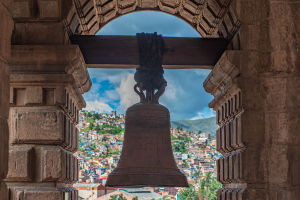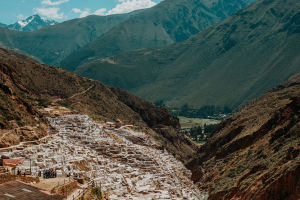Escape To Colca Canyon
The Colca Canyon is one of Peru's most impressive natural wonders, yet it remains a hidden gem often overlooked by travelers rushing to more famous sites.
For Lykkers looking to experience breathtaking landscapes, rich culture, and unique wildlife, this canyon offers an unforgettable journey.
Here is a detailed guide to what to expect, where it is, how to get there, and the best things to see and do.
Location and General Information
Where is the Colca Canyon?
Located approximately 160 kilometers northwest of Arequipa, the Colca Canyon lies in southern Peru. The journey from Arequipa to the canyon typically takes about 3.5 to 4 hours by road, crossing high Andean landscapes.
The canyon is the third most visited tourist destination in the country, celebrated for its incredible natural beauty and cultural significance.
How deep is the canyon?
At approximately 3,270 meters deep, Colca ranks as the second deepest canyon on Earth, surpassing many of the world’s most renowned gorges in size. It formed around 100 million years ago, making it a geologically young formation with steep walls carved by the Colca River.
Altitude considerations
Travelers encounter high altitude along the way, reaching nearly 5,000 meters at the Paso de Patopampa before descending to the town of Chivay at 3,635 meters. Adjusting to the altitude is important to avoid discomfort; spending time in Arequipa before heading into the canyon is recommended.
What Makes the Colca Canyon Special?
Rich history and culture
The valley has been inhabited for over 2,000 years by the Collagua people, descendants of ancient Andean cultures who preserved many traditions even through later empires. The name "Colca" originates from ancient granaries called "colcas," used to store food for difficult seasons.
Agricultural terraces
Around 8,000 hectares of pre-Incan terraces remain actively cultivated with potatoes, quinoa, and maize. These terraces showcase sustainable agriculture on steep mountain slopes and are an essential feature of the landscape.
Wildlife and nature
The canyon is one of the few places where the majestic Andean condor can be reliably seen. With a wingspan reaching nearly 3 meters, these birds soar using thermal air currents, especially in the early morning. The designated viewpoint, Cruz del Condor, provides an excellent observation spot.
The Colca River, flowing through the canyon, adds to the valley's biodiversity. Nearby nature reserves protect native animals such as vicuñas and guanacos, rare camelids of the Andes.
What to See and Do
Hiking and trekking
Trekking in the Colca Canyon is a popular activity. The most famous trail descends from the village of Cabanaconde to Sangalle Oasis, an idyllic green area at the canyon floor where accommodations are available.
Day hikes and longer treks provide options for different fitness levels and interests.
Cultural experiences
Small villages like Yanque, Maca, and Pinchollo are rich with traditional architecture and local customs. Visitors can explore buildings with baroque details, local markets, and witness folk dances such as the Wititi performed by residents in colorful attire.
Thermal baths
Natural hot springs near Chivay and Yanque offer relaxing spots to soak after trekking or sightseeing. Facilities usually include warm pools surrounded by mountainous scenery, perfect for unwinding.
Wildlife observation
Besides the condors, birdwatchers can visit Laguna de Salinas to spot three species of flamingos and other Andean birds during certain months when the lake is full.
How to Get There and Travel Tips
From Arequipa to Colca Canyon
Arequipa serves as the gateway city. Travelers can reach Arequipa by flight or overnight bus from Lima. From Arequipa, regular buses or private transfers take about 4 hours to reach Chivay, the main town in the Colca Valley.
Exploring the canyon
Chivay is a convenient base with lodging, restaurants, and access to tours. From there, the canyon’s main viewpoints and trails are easily reachable by short drives or guided excursions.
Best time to visit
The dry season from May to October offers clear skies and comfortable daytime temperatures ranging from 20 to 23°C, while nights can be chilly. The wet season, December to March, brings more rain and lush green landscapes but may complicate travel on some dirt roads.
Entrance Fees and Practical Information
Park entrance ticket
Visitors need to purchase an entry ticket to explore the Colca Canyon area, typically costing around $19 for foreigners. Some discounts apply for students and nationals. Cash is preferred, as card payments may not be accepted in remote villages.
Clothing recommendations
Layered clothing is essential due to temperature variations. A hat, sunglasses, sunscreen, comfortable trekking shoes, and windproof jackets are advisable. Staying hydrated and resting at altitude can help prevent discomfort.
Accommodation and Food
Where to stay
Chivay offers the widest selection of lodging, from budget hostels to mid-range hotels averaging around $30–50 per night. Smaller villages like Yanque and Cabanaconde also have guesthouses and eco-lodges, providing quieter options.
Local cuisine
Restaurants serve traditional dishes such as stuffed peppers (rocoto relleno), quinoa soup, and fresh river trout. Menus del día (set menus) in local eateries are affordable and give a taste of regional flavors. Kitchen closing times tend to be early, especially outside main towns.
In Conclusion
The Colca Canyon provides a captivating blend of natural grandeur, rich history, and vibrant culture that appeals to many travelers. From spectacular wildlife sightings and highland trekking to cultural festivals and soothing hot springs, this destination offers something unique for every visitor.
Planning a visit with enough time to acclimate, explore villages, and enjoy the landscape fully ensures a rewarding experience for anyone venturing into this impressive Andean valley.
-
 Discover Cusco's TreasuresFrom Stone Giants To Sacred Temples: What Makes Cusco A Living Museum?
Discover Cusco's TreasuresFrom Stone Giants To Sacred Temples: What Makes Cusco A Living Museum? -
 Salt Pools Of MarasHave You Seen The Stunning Salt Pools Of Maras Yet? Explore Peru's Ancient Natural Wonder!
Salt Pools Of MarasHave You Seen The Stunning Salt Pools Of Maras Yet? Explore Peru's Ancient Natural Wonder! -
 Top Baltimore HotelsThe Ultimate Baltimore Hotel List: Where Luxury Meets Charm and Comfort!
Top Baltimore HotelsThe Ultimate Baltimore Hotel List: Where Luxury Meets Charm and Comfort!
Contact to : xyjph123@gmail.com
Privacy Agreement
Copyright © boyuanhulian 2020 - 2022. All Right Reserved.
Privacy Agreement
Copyright © boyuanhulian 2020 - 2022. All Right Reserved.